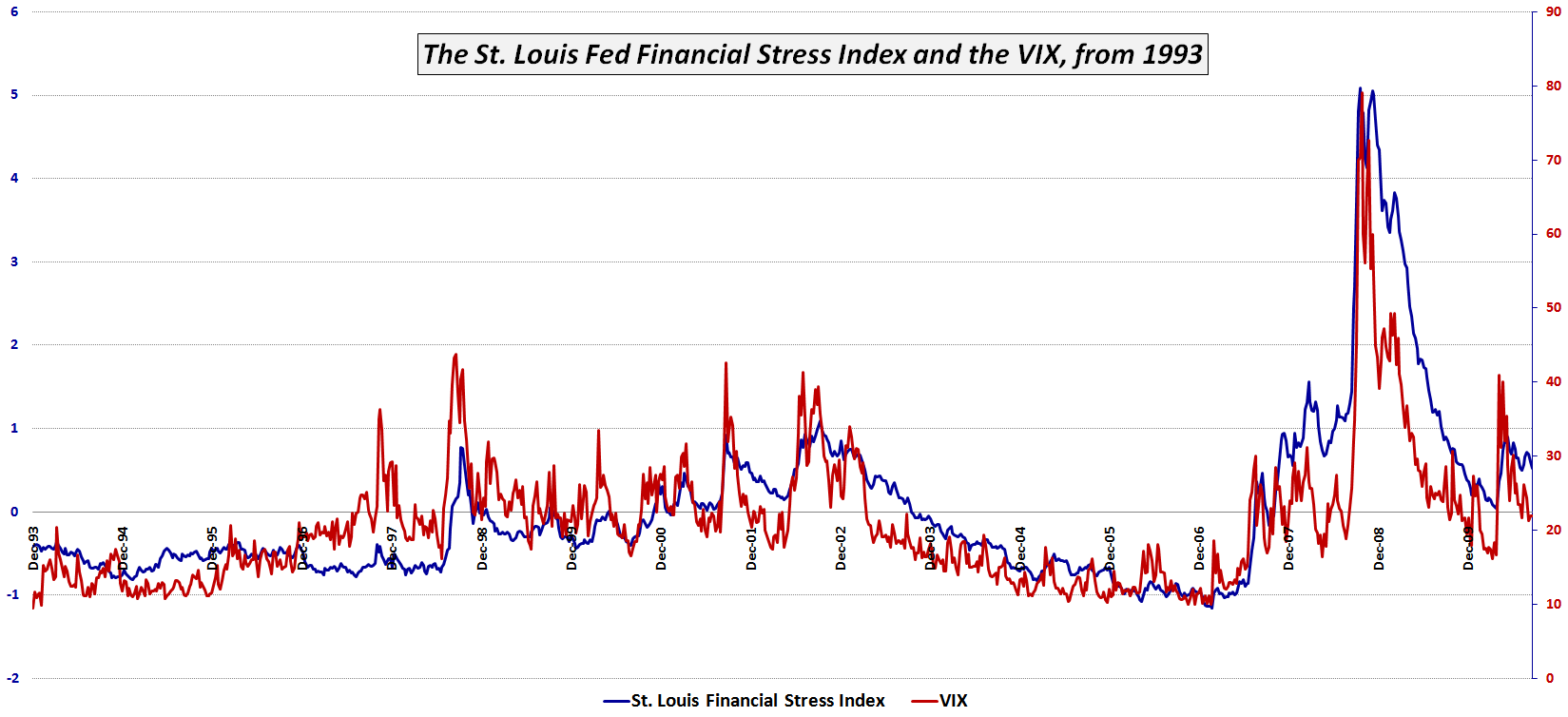St. Louis Fed’s Financial Stress Index
When I started this blog, I added what sounded like a whimsical tagline at the time, “Your one stop VIX-centric view of the universe.” In retrospect, perhaps the joke was on me, as the content here has consistently been VIX-centric, despite my occasional forays into that “and More” netherworld.
I will be the first to admit, however, that the VIX captures only a small slice of investor sentiment and represents only one type of threat to the markets.
Back in March 2007 I addressed a broader range of sentiment indicators when I wrote A Sentiment Primer (Long) and urged investors to take a broad-based view of threats to the market in The Credit Default Swap Canary. Along the way, I have been a strong proponent of using put to call ratios (Put to Call Everest), bond yields, the VIX divided by T- bill yields (VIX:IRX), the TED spread, counterparty risk measures, and other factors.
One excellent index which attempts to capture a broad range of components of financial stress is the St. Louis Fed’s Financial Stress Index, henceforth to be known here as the STLFSI. The index constituents are highlighted below and include an interest rate group, a yield spread group and an third uncategorized group of additional indicators in which the VIX is one of five components.
Interest Rates:The chart below shows the performance of the STLFSI and the VIX going back to 1993. Not surprisingly, there is a high degree of correlation. If one accepts the STLFSI as a more broad measurement of stress in the financial system, one can make a case that while the VIX is usually directionally correct, at certain times the VIX has underestimated the stress in the system (e.g., May 2008) while at other times the VIX has overestimated the stress in the system (e.g., May 2010). Going forward, I will make an effort to flag important divergences between the VIX and the STLFSI.
Yield Spreads:
- Effective federal funds rate
- 2-year Treasury
- 10-year Treasury
- 30-year Treasury
- Baa-rated corporate
- Merrill Lynch High-Yield Corporate Master II Index
- Merrill Lynch Asset-Backed Master BBB-rated
Other Indicators:
- Yield curve: 10-year Treasury minus 3-month Treasury
- Corporate Baa-rated bond minus 10-year Treasury
- Merrill Lynch High-Yield Corporate Master II Index minus 10-year Treasury
- 3-month London Interbank Offering Rate–Overnight Index Swap (LIBOR-OIS) spread
- 3-month Treasury-Eurodollar (TED) spread
- 3-month commercial paper minus 3-month Treasury bill
- J.P. Morgan Emerging Markets Bond Index Plus
- Chicago Board Options Exchange Market Volatility Index (VIX)
- Merrill Lynch Bond Market Volatility Index (1-month)
- 10-year nominal Treasury yield minus 10-year Treasury Inflation Protected Security yield (breakeven inflation rate)
- Vanguard Financials Exchange-Traded Fund (VFH)
Note that the Kansas City Fed has a similar Financial Stress Index, aka the KCSFI, which is more concise and more focused on yield spreads.
The St. Louis Fed has more information on the STLFSI here, while the Kansas City Fed has more information on the KCSFI here.
Related posts:
- Revisiting the Flight-to-Safety Trade
- Chart of the Week: The Flight-to-Safety Trade
- The Credit Default Swap Canary
- A Sentiment Primer (Long)
- Chart of the Week: Record Low Yields for the 2-Year U.S. Treasury Note
- Chart of the Week: 10-Year Treasury Note Yield
- Chart of the Week: Ratio of VIX to Yield on 3 Month T-Bills


